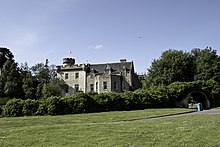Tulloch Castle
Tulloch Castle is a castle in the town of Dingwall in the Highland administrative district of Scotland . It probably began in the mid-16th century. Over the years it served as a family home for the Bains , Davidsons and Vickers , as an army hospital after the evacuation of Dunkirk, and later as a student residence for the local school administration. Currently it is used as a hotel and conference center.
history
Tulloch Castle is believed to date from the mid-16th century when Duncan Bane (or Bain , Bayne ) received the baronate of Tulloch in 1542 .
In the 18th century, however, the castle fell into other hands. Kenneth Bayne, 8th Laird of Tulloch , sold Tulloch Castle to his cousin Henry Davidson in 1762 . After Henry Davidson's death in 1781 inherited the womb of his younger brother Duncan Davidson , who was from 1790-1796 MP for the constituency of Cromartyshire . He in turn was followed by his son Henry Davidson (1771-1827), his grandson Duncan Davidson (1800-1881) and his great-grandson Henry Caithness Reay Davidson (1836-1889). The latter was the father of the last Davidson of Tulloch, Duncan Davidson (1865-1917).
In 1845 the castle was damaged by fire and expanded in 1891.
In 1917 the castle changed to an owner outside the Davidson family when Duncan Davidson died and bequeathed it to his daughter and son, Colonel Angus Vickers of the Vickers Aircraft Factory . The architect Sir Robert Lorimer designed conversions to Tulloch Castle, which were carried out in the early 1920s. After serving as a home for the Vickers family for several years and as an army hospital for the wounded in the Battle of Dunkirk in 1940 , the local school administration bought Tulloch Castle in 1957. It then served until 1976 as accommodation for students from the west coast of Scotland, who lived on the Dingwall Academy studied. After that, the castle fell into disrepair until it was renovated and converted into a hotel in 1996 by the local McAulay family . It is still in use as a hotel and conference center today, and in October 2007 the official Davidson clan meeting took place there.
Historic Scotland has listed the castle as a Category B Historic Building.
Ghosts
There are several reports of ghosts visiting Tulloch Castle. Visitors and hotel workers said they witnessed apparitions of a young girl and a middle-aged lady. These reports of supernatural phenomena were 2,005 of the series Beyond Explanation of the television company Grampian Television examined, although no conclusive evidence found of such phenomena. On May 28, 2008, Sun News reported that a 14-year-old boy named Connor Bond apparently took a picture (with a digital camera) of a "hand" clinging to a banister and followed by a floating apparition. Since May 28, 2008 his photos have been examined by film experts and those for paranormal phenomena.
estate
The castle grounds are home to many interesting details. A tunnel ran from the basement of the castle and the town of Dingwall to the site of the old Dingwall Castle . Today the tunnel collapsed, but you can see this passage through a ventilation shaft on the lawn in front of the castle. There is a Davidson cemetery on the castle grounds where family members and pets were buried. The cemetery is surrounded by a metal fence and is now overgrown, but the tombstones can still be seen. Originally there were two enclosed gardens on either side of the castle. These too have overgrown and parts of them have become forests or houses have been built on them. The castle had two gatehouses on the entrance ways. The western gatehouse no longer exists today, but the eastern one has since been converted into a private residence. This gatehouse was built in 1876 and the connecting path between it and the castle was rededicated as a public road. This street now serves as the main entrance to the hotel.
On a hill north of the castle stands Caisteal Gorach , a folly from the end of the 18th century that the architect Robert Adam designed for Duncan Davidson. The Folly consists of the ruins of a round tower with flanking walls and Historic Scotland has listed it as a Category A Historic Building.
Individual evidence
- ↑ Tulloch Castle . Scottish Castles Association. Retrieved February 22, 2018.
- ↑ James Alan Rennie: The Scottish People: Their Clans, Families, and Origins . Hutchinson. S. 119. 1960. Retrieved February 22, 2018.
- ↑ David R. Fisher: DAVIDSON, Duncan (1733-99), of Tulloch, Ross and Myles's, Ongar, Essex . In: The History of Parliament: the House of Commons 1790-1820 . 1986. Retrieved February 22, 2018.
- ↑ David R. Fisher, David R. Fisher: DAVIDSON, Duncan (? 1800-1881), of Tulloch Castle, Dingwall, Ross . In: The History of Parliament: the House of Commons 1820-1832 . 2009. Retrieved February 22, 2018.
- ^ Charles Mosley: Burke's Peerage . 107th edition. 2003. Volume IS 1049, cited in: Darryl Lundy: Duncan Davidson of Tulloch . thepeerage.com. Retrieved February 22, 2018.
- ↑ Martin Coventry: Tulloch Castle . In: The Best Castles . The Castles of Scotland. Retrieved February 22, 2018.
- ↑ a b Listed Building - Entry . In: Historic Scotland .
- ↑ Tulloch Castle Hotel . Bespoke Hotels Ltd .. Retrieved February 22, 2018.
- ↑ 2007 International Gathering at Tulloch Castle . Clan Davidson Association. Retrieved February 22, 2018.
- ↑ Listed Building - Entry . In: Historic Scotland .
swell
- Brochure Tulloch and The Lands .
Web links
Coordinates: 57 ° 36 '34 " N , 4 ° 25' 21.4" W.

